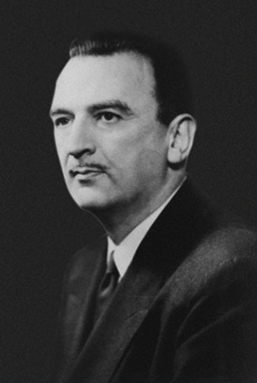
Arthur Sudler’s interest in the visual arts, his identification with artists, and his personal talents as a painter had a profound influence on the style of medical advertising in its heyday—the 1950s-1960s—and continuing on into the present. Sudler was educated as an artist, attending the Maryland Institute of Fine and Applied Art and studying with such renowned American painters as John Sloan and Robert Henri. His works have been displayed in New York galleries and are part of museum collections.
Sudler was born in 1905, inauspicious timing for a serious art career when the Great Depression struck America in 1929. He went to work for E.R. Squibb, rising to become the company’s creative director and, eventually, going out on his own in 1936 to found an art studio with Squibb as the principal client. Matthew Hennessey, who had also been at Squibb, joined him.
The studio’s output was largely window displays, sales aids, and in-store materials. Medical advertising was not a significant promotional activity for Rx companies. Their major sales efforts were their sales forces. Still, this kind of work was sufficient for the business to grow and be ideally positioned to take advantage of the post-World War II boom in pharmaceuticals.
Sudler, however, had not limited his reach to pharmaceutical clients. The studio had attracted a broad spectrum of business from consumer- and trade-oriented companies for design assignments on corporate identity, publications, illustrations, etc. To service these clients, Sudler formed an important alliance with the brilliant designer, Herb Lubalin, and with this luminous creative star, he attracted a memorable group of young art directors who would leave their marks on medical and consumer advertising: Ernie Smith, George Lois, Fred Pappert, Sam Scali, and Helmut Krone. Sudler’s eye for graphic talent extended to his incorporation of the works of Ronald Searle, Charles Addams, and Andy Warhol into the studio’s output. Notable clients were McCall’s, Saturday Evening Post, and Ladies’ Home Journal; record covers for RCA and Columbia, and campaigns for CBS. As evidence of S&H’s reputation for design, NBC turned to the studio for a logo and was rewarded with the memorable, multicolored peacock.
With such a talent base and reputation, it is not surprising that Sudler tried his hand at consumer advertising, setting up Sudler Hennessey & Lubalin. The new company produced award-winning ads, but was not sufficiently profitable to be continued, particularly with the opportunities pharmaceutical promotion presented in the 1950s. Early Rx accounts were Merrell and CIBA. Sudler also recognized the potential for pharmaceutical promotion overseas and organized Arranz & Sudler to serve international clients.
Throughout the 1950s, into the 1960s, and continuing into the present, S&H produced a body of work which displayed a graphic look that became recognized as “pharmaceutical advertising design.” The style relied on full-page, provocative visual elements linked to equally provocative headlines that amplified on the illustrative material. Both art and copy dramatized and translated into human terms the product’s technical features and competitive claims. Sudler’s taste and visual sensitivity animated the style, which radiated throughout medical advertising and influenced consumer advertising as well.
Sudler is remembered as a generous, caring, cultured leader with a legendary ability to recognize and nurture creative talent. Unfortunately, his health began to fail in his early 60s and he retired from the agency in 1966, eventually dying in 1968.
The foundation he had laid and the standards he had set for the organization were so enduring that his surviving partner, Hennessey, was able to make S&H the largest medical agency in the US for a period of 20 years (1970s-1990s).